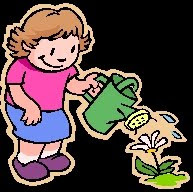I think the way we present new foods to Infants & Toddlers is very important in the development of life long eating habits. Food should never be used as a reward for good behavior or as a way to soothe emotional or physical hurts. Withholding food as punishment also gives food on an emotional connotation that may lead to bad eating habits later in life. The older a child is before they know about the existence of fast foods and sweets the better chance they have of not being hooked on these high calorie but nutrient barren foods. Teaching kids that food is only needed for energy to grow and stay healthy would go a long way toward keeping food in the proper perspective in life. A young child's diet should be lots of fruits and vegetables. "Feed Me I'm Yours" by Vicky Lansky is a great book for parents and caregivers to learn about the proper feeding of young children. I highly recommend it. Some other observations:
1. Kids go through cycles where they eat very little and then eat everything in sight. Pay attention to these cycles and let the child's appetite rule the amount of food they eat. Don't force them to eat when they are not hungry and don't worry about it if they skip a meal or two. They'll eat when they're hungry.
2. Avoid fruit juice....it's highly processed, has concentrated sugar and usually the processor adds more and most of the nutrients and all of the fiber has been removed. Better to drink water.
3. Follow the child's lead for introducing meats. Most toddlers and many preschoolers don't want or need meat.
4. Offering young children a wide variety of fresh, healthy food is the best way to insure that they get the nutrition they need. Avoid everything that is highly processed.
If you want to improve your own health and your relationship with food, read "Eat to Live" by Dr. Joel Furhman.

A question to ponder: How can we decrease the emphasis on food for holidays, celebrations and other social occasions?
















